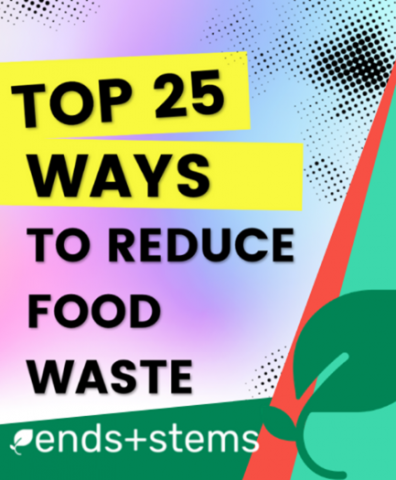The question I am most frequently asked is: “What’s the best/easiest/most impactful way to start reducing my food waste at home?”
It’s a great question and I’m always happy to respond that there are many ways to get started. Below is a list of the Top 25 Ways to Start Reducing Food Waste. They aren’t in any particular order, so you can select the ones that seem possible for your life. I’d wager that as you start getting comfortable with a handful of new habits, you’ll revisit the list and add a few more to your normal week.
1. Meal Plan
Decide which recipes you’ll cook this week before heading to the store.
2. Shop From a List
Write a list and stick to it while shopping! (Check out Stop Food Waste's Shopping List)
3. Check Your Pantry First
Relying on your memory is faulty - Check what you actually have at home before you shop.
4. Eat Leftovers
Cooking the exact amount you need is challenging, so if there’s food leftover, pack it for lunch or designate a “Leftovers Night” once per week to clean out the fridge.
5. Willpower and Reward
Just override the desire for take out tonight. Eat what you know has been in the fridge and will be tossed out soon. Reward yourself for taking this step tonight by ordering in your favorite meal tomorrow.
6. Eat Ugly
Ugly produce is having its moment. You may see it as a delivered farm box, in your local grocery store aisle, or at the farmer’s market. Another way to think about it though, is once you have produce at home, if it starts wilting, browning or growing eyes, etc, use it up! Slice off the affected part and either eat it or freeze it asap.
7. Eat Less Meat
A plant heavy diet is the future of environmental eating. Animals require more resources to grow, produce, and distribute so wasting any amount of beef or pork has a much larger negative impact than wasting an apple. If you’re buying less meat, you’re more likely to savor it and waste it less.
8. Put Down the Peeler
Stop peeling carrots, cucumbers, potatoes, apples, and eat them all the way through! Use a coconut fiber vegetable scrubber and save time and reduce edible waste by eating, not peeling.
9. Eat Your Ends + Stems
Many vegetables have parts that might not be fully utilized in traditional recipe writing. Broccoli stalks, for example, are trimmed away though they’re arguably the more delicious part. Eat your parsley stems, beet tops, kale stems, celery leaves, etc.
10. Utilize Scraps for Stock
For items that do produce “inedible” waste, make stock. Chicken bones, winter squash peels/guts, onion skins, even apple cores turn “garbage” into kitchen gold.
11. Be Creative, Recipes are Guidelines
If you get halfway through a recipe and are missing an ingredient, make a substitution! Parsley for basil, mozzarella for ricotta, carrot for sweet potato. Most savory cooking is adaptable and as you gain practice and confidence you can cook from your fridge rather than running out to the store.
12. Proper Storage
When groceries are stored properly you’ll get more shelf life from them and more time to use them up. (Download the Stop Food Waste Storage Guide)
13. Declutter
Keep your food storage and refrigerator areas organized and pared down. If you can’t see what you have, you’ll never use it up.
14. FIFO
A professional chef rule of thumb: First In, First Out (FIFO). When unloading your groceries rotate older items to the front so they’ll be grabbed first. In the fruit bowl, for example, place new apples underneath older ones which become easier to grab. (Consider using an "Eat This First" sign to make sure everyone else in your home knows to do this too!)
15. Understand Expiration Dates
With the exception of infant formula, there are zero (zip, zlich, nada!) regulations or standards currently applied to Best By, Use By, Eat By, Sell By date. Learn to trust your senses to tell if something has turned. Most dairy is good for days after the date, eggs can stay fresh for months! (Download a date label guide here)
16. Measure
Run a food waste audit in your home to find out exactly what you’re home often wastes. Lucky for you, Ends+Stems has a full Food Waste Audit Guide for you! (link: https://endsandstems.com/conduct-a-food-waste-audit/)
17. Serve Smaller Portions
American dinner plates have increased in size by 36% since the 1960s. In Europe, the average restaurant plate is 9 inches to the U.S.’s 12 inches. Not only will serving smaller portions reduce your food waste, it could help your health and waistline. If you’re still hungry, just go for seconds!
18. Teach Kids Why
Teaching our kids to respect where food came from, the resources put in to grow, pack, ship and cook food, teaches them to be mindful of waste for the good of the planet.
19. Donate Extras
Many areas have local app or organizations that accept extras. Try to donate to your local food banks or shelter. This can be done year round, not just the Thanksgiving canned goods drive.
20. Geek Out on Old-School Shelf-life Boosters
Canning, fermenting, pickling are all ways to extend the life of a product or rescue it from going bad.
21. Leverage Your Freezer
Romaine, strawberries, and avocados, for example, can be frozen and turned into smoothies. Cooked grains and rice can go in, sauces, and meat too. Just remember to label and date everything!
22. Feed Friends, Then Consider Animals
We love the idea of a leftover swap or cooking swap with friends and neighbors (you make a double batch of lentil soup, they make double roast chicken, then swap!). If you have animals who can be fed, that is a better use than even the compost bin. Maybe you have goats, pigs, chickens nearby who need a meal.
23. Order Smarter at Restaurants
Up to a half pound of food is wasted per restaurant meal served, some of that in the kitchen, but 17% of that waste is from consumers not joining the clean plate club. So order less, or take home (and use your willpower to eat) those leftovers! If you know a restaurant owner to see a suggestion box, ask them to use smaller plates, serve smaller portions, or consider selling half portions.
24. Composting is *A Bit* Better
Composting is better than the landfill, but only by a little. Edible food that gets composted is still wasting the water, gas, labor, growing space, and time that was spent growing that food. (Learn more about home composting here)
25. Forget Perfection
This is not a zero sum game. If you have a bad (food waste) day or you just can’t engage your willpower to follow through on leftovers today it’s ok. Start again tomorrow. Awareness and effort are the most important first steps to change. We’re here for you and you’ve got this!
Tips courtesy of Stop Food Waste Chef Partner, Chef Alison Mountford. Visit Ends + Stems for more meal planning tools, recipes, and inspiration to reduce wasted food in your kitchen.












